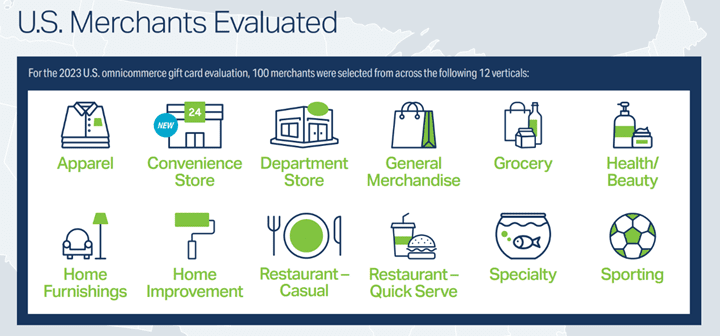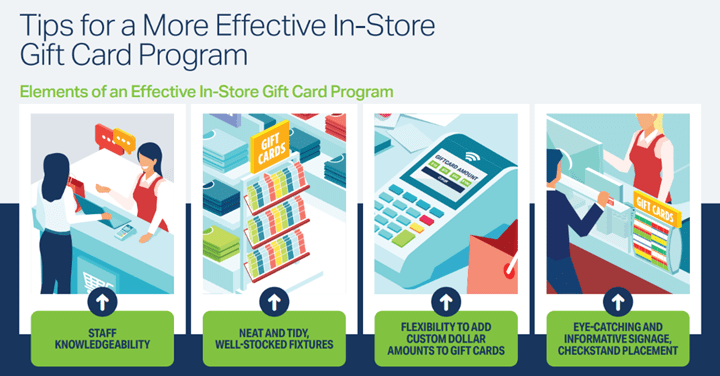Gift cards continue to grow in popularity in the United States, with roughly 75% of consumers having purchased a gift card within the past 12 months, according to recent data from BHN (Blackhawk Network) research.
For the sixth year in a row, BHN has joined forces with NAPCO Research to conduct a comprehensive benchmark study, examining the gift card programs of more than 100 merchants in the U.S. Based on 175 criteria, the report assesses their in-store, online and mobile gift card offerings, including the consumer purchase and recipient experience. This year a limited assessment of 25 digitally ascendant brands was also included.
During a PaymentsJournal podcast, Sarah Kositzke, Sr. Global Market Research Manager at Blackhawk Network, Andrew Solomon, Vice President of Sales at Blackhawk Network, and Jordan Hirschfield, Head of Prepaid at Javelin Strategy & Research, discussed how businesses can build—or evolve—their gift card programs.
The Increasing Benefits of Gift Cards
The 2023 Merchant Gift Card Omnicommerce Evaluation examined gift card programs across various platforms, including physical stores, websites, and mobile apps. By evaluating criteria such as accessibility, options, and recipient experience, the study revealed crucial insights for merchants seeking to optimize their gift card initiatives.

The U.S. gift card market is expected to reach $260 billion by 2026. The digital gift card market is also seeing significant growth and is expected to reach nearly $135 billion by that same year.
“Digital gift cards continue to be the most requested gift for 16 consecutive years,” Solomon said.1
Although the rise of digital gift cards is undeniable, a significant portion of gift card purchases still occur in-store at physical retailers, including grocery stores, convenience stores, and pharmacies. When it comes to the types of gift cards customers prefer that is also shifting toward versatile options like Visa or Mastercard gift cards and multi-branded gift cards that offer a range of choices of where to shop/dine.
“Blackhawk’s findings align with our research and reveal similar patterns,” Hirschfield said. “Third-party retailers, including big-box stores, supermarkets, and online retailers, continue to be popular destinations for purchasing gift cards, whether for personal use or as gifts for others.”
Gift cards also can expose consumers to new stores.
“During the holidays, we discovered that almost a quarter of gift card recipients received a gift card to a new place they hadn’t tried before,” Kositzke said. This means gift cards not only allow recipients to explore new products at stores they already know and love, they also open the door for consumers to explore entirely new brands and retailers.”
Gift cards can also help strengthen loyalty programs. Across various industries, belonging to a loyalty program increases spending and encourages the self-use of gift cards.
“Blackhawk’s report found that around four in 10 people tend to use gift cards for themselves, similar to what we have observed,” Hirschfield said. “Loyalty programs provide ongoing benefits and create a lasting relationship with customers, rather than being a one-time use experience.”
Where to Begin
For merchants looking to start or improve a gift card program, there are some best practices to consider. When it comes to the placement of gift card fixtures in stores, for example, it’s important to consider consumer behavior, particularly when many consumers tend to pair a gift card with another gift item.
“Strategically placing the gift card displays near related items can make it convenient for customers,” Kositzke said. “For example, place them near the greeting card section and near chocolates and flowers, which are commonly paired with gift cards.”
Solomon agreed that it’s important to think about the size, appearance, and placement of the fixtures in a physical store. “Can you make them more eye-catching with colors and lighting? Consider using special displays or holiday-themed shippers at checkout. Pay attention to the marketing and theme around the gift cards and make the carrier (the packaging) feel special and different for holidays,” he said.
“On the digital side, focus on creating a great mobile experience,” he added. “Innovations like unwrapping the gift card in a mobile setting can enhance the user experience. We actually had to add in rewrapping the gift card because people like unwrapping and rewrapping it.”
Lastly, don’t forget about loyalty programs, which play a significant role in today’s retail landscape. Retailers can attract customer loyalty by offering incentives like earning points when they purchase multiple gift cards. This not only encourages customers to choose that retailer but also provides them with additional benefits, such as fuel savings or rewards.
“Mobile apps are a key driver in enhancing loyalty programs,” Hirschfield said. “They allow customers to easily link physical gift card purchases and load their balances digitally, creating a seamless experience. By offering instant rewards and bonuses, such as a $5 digital gift card, customers feel valued and motivated to try new products or indulge in extras.”
The Impact of Digital on Gift Cards
Digital gift cards are gaining ground. According to the NAPCO research, there’s now roughly a 60/40% split between physical and digital cards, with digital gift cards growing in popularity.
“Currently, the average value of digital cards is slightly lower, around $30, compared to physical cards,” Hirschfield said. “However, what’s interesting is that people are using digital cards just as much, if not more, than physical cards. When it comes to unused balances, the median remaining balance for physical cards is about $1, which can be difficult to use. But for digital cards, the median remaining balance is zero, meaning people are able to use the full value of their digital cards.”
According to Solomon, it’s crucial to focus on a few key aspects to ensure a successful digital program:
- Invest in a risk management system that knows the difference between a fraudulent transaction and a legitimate one. False declines can damage your reputation.
- Sell your own branded gift cards across various channels, including your own website.
- Offer multiple payment options, such as Venmo, crypto, and buy now, pay later.
- Enhance the recipient’s experience, even in digital formats, through animated cards or interactive elements.
- Notify customers about their purchases and gift card deliveries, si they don’t forget about their gift cards.

“Digital channels also allow for higher initial gift loads compared to physical cards. Moreover, digital options are beneficial for those who can’t travel during the holiday season,” Kositzke said. “It ensures that gifts can be delivered safely and easily, making it a great alternative for sending presents to others.”
Conclusion
The gift card industry is experiencing significant growth, and this presents valuable opportunities for merchants. The BHN and NAPCO research emphasize the importance of enhancing the recipient experience, offering multiple payment options, and leveraging digital platforms to cater to consumers’ evolving needs. Furthermore, digital gift cards are a convenient and effective solution for corporate incentives, particularly for businesses with dispersed employees. By embracing digital channels, merchants can expand their customer base and provide a seamless gift-giving experience.
1 Source: *NRF and Prosper Insights & Analytics 2022 Consumer Holiday Survey
Click HERE to receive the full 2023 Merchant Gift Card Omnicommerce Evaluation report.
Fill out this form to talk to BHN










